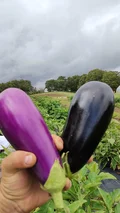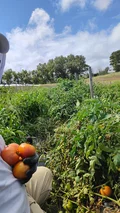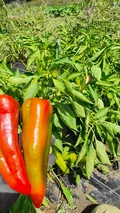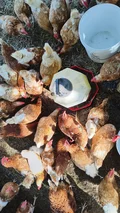TL;DR
We harvested tomatoes, eggplants, bok choy, squash, cucumbers, and sunflowers today. It was perfect farming weather, 65°F with breezes and no bugs. I also had time to reflect on the importance of social interaction in farming, both external and internal to the farm.
In my blogging tech work, I added a few new processes to further automate detection of missing media files (photos at least) and the need for a PR (pull request) to be created once the media tags and human writing are applied to the blog post.
Harvesting So Many Tomatoes
Today, we harvested many things, but especially the four tomato field rows and in the new greenhouse. In total this resulted in 15 trays of tomatoes, where when on average there are anywhere from 20-25 slicer tomatoes per tray, this means we harvested between 275-325 big tomatoes today and a few full trays of cherry varieties. In total, it took about four of us 2 hours to complete this work.
This is what it looks like from the field (video), maybe if you were a bee living the good life:
While We Work, We Listen and Talk
To pass the time while we work, we talk. We share stories, jokes, music, TV and movie recommendations, recipes, and tips about farming. We listen to each other’s perspectives and ideas. We learn from each other and grow together. New team member compatibility can also be assessed and improved through these interactions. It’s only natural for us to do this, and it’s a key part of what makes farming a rewarding and fulfilling experience.
In aggregate, these micro-interactions build trust and understanding between farm staff which is essential for effective teamwork. They also help to create a positive and supportive work environment which leads to increased job satisfaction and retention…when done well. Sometimes there’s too much talk hinging on cultural or generational references which can be difficult for some people to understand or relate to, but it’s all part of us learning from each other.
We often also share lunch together, which is a great way to bond and build relationships with our coworkers. There are many times where a special snack or dessert is brought by someone which is also a great way to show appreciation to and for each other
Social Interactions of Small Farms
Every farm makes it’s own unique decisions about its business model, its goals and targets, how it complies to regulatory standards, and how it interacts with it’s community and customers. Some of these factors are more under the control of the farmer, while others are more influenced by external factors such as market demand, government regulations, and consumer preferences.
While all this sounds very kumbaya, camaraderie developed in the field is visible to customers. How the farm staff interact with each other and the community is a key factor in the farm’s success. What’s inside a person often determines what comes up outside by default. It’s important to be aware of what is ‘internal’ vs. what is ‘external’ to a small farm’s operations.
This paradigm of ‘internal vs. external’, when combined with the lens of ‘unidirectional vs. bidirectional’ communication, can help us visually map out communication activities involved in farming. If we take a moment to quadrant these dynamics out, it might look like the following:
To be clear, this is just a sketch of an idea based on my limited but growing experience in farming and it’s business modeling. I’m open to feedback and suggestions on how to improve it, especially references to prior works that I might not be aware of.
Every Farm Is Social
Though my experiences in farming are limited, I listen to a wide variety of podcasts and audible sources while driving and working on the farm. My internship focus is small, independent organic farm operations but these other sources help me round out my understanding of the industry.
One podcast I’ve recently been enjoying the learnings from is Singular Agronomics because it’s non-militant and yet educational approach to sharing the whole story on particular practices via guest speakers, farmers, and industry researchers. Without socializing this information, I wouldn’t otherwise have learned about many of these deeper soil health topics. The way I see it, diversity in personal research, just like diversity in soil biology, is vital to developing my understanding of farming in a well-rounded manner.
Every farm can’t devote a lot of time to publishing videos and articles, but they can still share their knowledge and experiences with their community. By sharing their knowledge, farmers can help others learn and grow, and in turn, help themselves grow as well.
How Tech and AI Could Encourage Social Interaction
What I often see is that when people do their work, they leave even greater opportunity for group collaboration and creative thinking on the table by not capturing, refining, and sharing the details they encounter in their daily activities. There is a lot of opportunity for innovation and growth in this space, but only if it is radically easy to do these things in a way that doesn’t add (much) overhead to the work itself.
About 10 years ago, I was introduced to a publication called “The Creative Thinker’s Toolkit” by Gerard Puccio which helped me understand that creativity is a process as much as if not more than an innate skill certain people posses. It also catalyzed my hunch that social interactions lead to better and more creative outcomes, something that came in handy in my career as a director of incubation engineering. This backdrop of creativity is perpetually in my mind while I work on the farm and especially so with the recent explosion of technological advancements driven by the AI craze.
Recently, I watched a video featuring Po-Shen Loh about his research at Carnegie Mellon University around social entrepreneurship via elementary and high school students.
Similarly, I feel that many of the internal social interactions on farms can be an incubator for micro-innovations but also the next generations of agricultural leaders. I know that farm work isn’t everyone’s cup of tea, but it teaches people that seemingly insurmountable piles of work and projects can be accomplished through collaboration and perseverance.
Having individual experiences and developing personal work ethic is the first step, but sharing it in real-time along the way can be a challenge. It takes time to observe, reflect, converse, refine, and put into practice profound knowledge. So while it takes time to do this human learning, much of the busy work about the real-time capture and then rapid synthesis of the information can be automated.
While working around the farm, it should become natural to say what you are doing and what you observe into something like a smart watch or voice assistant on a mobile device. Of course, as others on the team might also be doing this, a way to aggregate and share this information in real-time would be a great addition to the farm’s communication and collaboration tools. This is, I think, a worthwhile area of investigation and prototyping for me over the next year.
Living in My Own Glass Apparatus
All of my custom code and supporting services runs in my homelab. Every week, I have a reminder to check the backups and mitigate any infrastructure issues that might prevent me from being able to publish my daily notes. Last week, I had to do some storage rearranging on my Kubernetes cluster, which caused me to miss publishing my daily notes for a few days.
Sometimes this setup is more fragile than I like, but I certainly learned how to do an in-place LMV partitions resizing without messing it up. Even with full backups, the thought of it going wrong and having to rebuild the homelab server is daunting, even if I should be able to do it and exercise my disaster strategy (DR) process occasionally.
Fortunately, the homelab server is running very smoothly now that the primary partition has been resized, which means all of the silly LLM-driven summarization process I’ve added to this blog works again to bring you a summary of my daily notes below:
AI Summary from Field Notes
Consolidated Summary
Main Themes:
- Weather and Conditions: Ideal farming conditions (65-70°F, breezy, no bugs, minimal rain) facilitate efficient harvesting.
- Harvesting Activities: Focus on tomatoes (greenhouse/field), eggplants, squash, and peppers, with attention to timing and quality.
- Crop Management: Cleaning plants (peppers, sunflowers) and weeding in landscaping fabric patches.
- Animal Care: Routine chores for chickens and pigs.
- Logistics and Prep Work: Preparing for market (sunflower packing, van loading) and future tasks (row cover setup).
Activities Performed:
- Chicken and Pig Chores: Filling water, feeding, and cleaning basins.
- Harvesting:
- Eggplants, squash, and tomatoes (7 trays greenhouse, 6-7 flats field).
- Carmines peppers (first harvest, with cleanup of overripe/rotting fruit).
- Weeding: Removing thick, large weeds in landscaping fabric patches.
- Sunflower Harvesting: Stripping and cutting sunflowers for market.
- Prep Tasks:
- Preparing landscaping fabric for row cover.
- Packing electric van for Innesquam market.
- Monitoring: Checking on animals at day’s end.
New Things Encountered:
- Carmine Peppers: First harvest of this crop, requiring attention to ripeness and quality.
- Weed Management in Fabric: Challenges in controlling weeds in landscaping fabric patches.
- Sunflower Processing: First experience with sunflower storage and market preparation.
Questions for Future Research:
- How to optimize pepper ripeness monitoring and harvesting schedules?
- What strategies prevent weed competition in landscaping fabric patches?
- How does weather (temperature, rain) affect crop quality and harvesting efficiency?
- What methods ensure sunflower storage before market?
- How to properly install row cover for lettuce planted by volunteers?
Suggested Actions:
- Monitor Peppers: Track ripeness and adjust harvesting schedules.
- Weed Fabric Patches: Schedule regular weeding to prevent crop competition.
- Prepare Row Cover: Ensure fabric is properly laid before lettuce planting.
- Optimize Sunflower Storage: Develop a plan for cooling or storing sunflowers.
- Document Weather Impact: Record how weather conditions affect crop quality and efficiency.
Part 1
Main Themes:
- Weather and Conditions: The day was ideal for farming (65-70°F, breezy, no bugs, minimal rain).
- Harvesting Activities: Focus on tomatoes (greenhouse and field), eggplants, squash, and peppers.
- Crop Management: Cleaning up plants (peppers, sunflowers) and weeding in landscaping fabric.
- Animal Care: Routine chores for chickens and pigs.
- Logistics and Prep Work: Preparing for market (sunflower packing, van loading) and future tasks (row cover preparation).
Activities Performed:
- Chicken and Pig Chores: Filling water buckets, feeding, and cleaning basins.
- Harvesting:
- Eggplants and squash.
- Tomatoes (7 trays from greenhouse, 6-7 flats from field).
- Carmines peppers (first harvest, with cleanup of rotting/overripe parts).
- Weeding: Removing thick, large weeds in landscaping fabric patches.
- Sunflower Harvesting: Stripping and cutting sunflowers for the market.
- Preparation Tasks:
- Preparing landscaping fabric for row cover.
- Packing electric van for Innesquam market.
- Monitoring: Checking on chickens/pigs at the end of the day.
New Things Encountered:
- Carmine Peppers: First harvest of this crop, requiring careful selection of ripe (50% red) vs. green fruit.
- Weed Management in Landscaping Fabric: Thicker, larger weeds in fabric patches, requiring more intensive weeding.
- Sunflower Processing: Stripping sunflowers for market (e.g., for sale or use in a facility).
Questions and Future Research Areas:
- Pepper Harvesting: How to optimize timing for carmine peppers to avoid over-ripening or under-ripening.
- Weed Control in Fabric: Effectiveness of landscaping fabric in preventing weed growth over time.
- Weather Impact: How consistent weather (e.g., heat, rain) affects crop yield and harvesting.
- Sunflower Market Use: Best methods for preserving or preparing sunflowers for the market.
- Row Cover Preparation: How to properly install row cover for lettuce planted by a volunteer group.
Suggested Actions:
- Monitor Peppers: Track pepper ripeness and adjust harvesting schedules as needed.
- Weed Landscaping Fabric Patches: Schedule regular weeding to prevent competition with crops.
- Prepare for Row Cover: Ensure landscaping fabric is properly laid before planting lettuce.
- Optimize Sunflower Storage: Develop a plan for cooling or storing sunflowers before the end of the day.
- Document Weather Impact: Record how weather conditions (e.g., temperature, rain) affect crop quality and harvesting efficiency.
[end of post]
Enjoy Reading This Article?
Here are some more articles you might like to read next:






